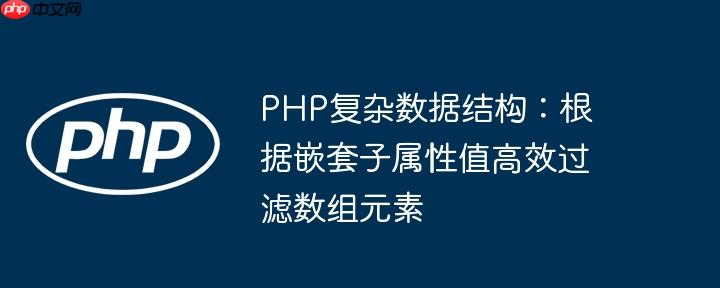
在php开发中,我们经常会遇到多层嵌套的数据结构。本教程所面对的数据结构示例如下:一个数组包含多个对象,每个对象内部又包含一个数组,该数组的元素是对象,这些对象内部再嵌套对象,直至最深层包含我们需要判断的 signature 属性。
[
{
"id":6834,
"contract_id":13,
"schedule_column_values":[
{
"id":34001,
"field_value":{
"id":324241,
"value":10,
"field":{
"id":1,
"signature":"ios"
}
}
},
{
"id":34001,
"field_value":{
"id":324241,
"value":10,
"field":{
"id":1,
"signature":"android"
}
}
}
]
}
]我们的目标是:如果 schedule_column_values 数组中的任何一个元素的 field_value->field->signature 属性值为 "android",那么就将该元素(即 schedule_column_values 的直接子元素,其 id 为 34001 的对象)从 schedule_column_values 数组中移除。
直接使用 unset 或在循环中修改原始数组可能会导致意外行为,例如跳过元素或索引错乱。此外,如果目标是移除整个“祖父级”对象(即 schedule_column_values 中的元素),而不是将其设置为 NULL,则需要更精细的过滤方法。
处理此类需求,array_filter 函数是PHP中非常强大的工具。它允许我们通过一个回调函数来过滤数组中的元素,只保留那些回调函数返回 true 的元素。结合对外部对象的迭代和克隆,我们可以安全地构建新的、符合条件的数据结构。
核心思路如下:
立即学习“PHP免费学习笔记(深入)”;
以下是实现上述逻辑的PHP代码:
<?php
// 假设这是你的原始数据
$data = [
(object)[
"id" => 6834,
"contract_id" => 13,
"schedule_column_values" => [
(object)[
"id" => 34001,
"field_value" => (object)[
"id" => 324241,
"value" => 10,
"field" => (object)[
"id" => 1,
"signature" => "ios"
]
]
],
(object)[
"id" => 34001,
"field_value" => (object)[
"id" => 324241,
"value" => 10,
"field" => (object)[
"id" => 1,
"signature" => "android"
]
]
],
(object)[
"id" => 34002,
"field_value" => (object)[
"id" => 324242,
"value" => 20,
"field" => (object)[
"id" => 2,
"signature" => "web"
]
]
]
]
],
(object)[ // 另一个外层对象示例
"id" => 6835,
"contract_id" => 14,
"schedule_column_values" => [
(object)[
"id" => 34003,
"field_value" => (object)[
"id" => 324243,
"value" => 30,
"field" => (object)[
"id" => 3,
"signature" => "android"
]
]
]
]
]
];
$filtered_data = []; // 用于存储最终过滤结果的数组
// 遍历最外层的“祖父级”对象
foreach ($data as $grandparent) {
// 使用 array_filter 过滤 schedule_column_values 数组
// 回调函数检查 field_value->field->signature 是否不等于 'android'
$filtered_schedules = array_filter(
$grandparent->schedule_column_values,
function ($item) {
return $item->field_value->field->signature !== 'android';
}
);
// 克隆当前的“祖父级”对象,以避免直接修改原始数据
$altered_grandparent = clone $grandparent;
// 将过滤后的 schedule_column_values 赋值给克隆后的对象
$altered_grandparent->schedule_column_values = array_values($filtered_schedules); // array_values() 重置数字索引
// 将处理后的对象添加到结果数组中
$filtered_data[] = $altered_grandparent;
}
// 打印过滤后的数据,以便查看结果
echo json_encode($filtered_data, JSON_PRETTY_PRINT);
?>输出结果:
[
{
"id": 6834,
"contract_id": 13,
"schedule_column_values": [
{
"id": 34001,
"field_value": {
"id": 324241,
"value": 10,
"field": {
"id": 1,
"signature": "ios"
}
}
},
{
"id": 34002,
"field_value": {
"id": 324242,
"value": 20,
"field": {
"id": 2,
"signature": "web"
}
}
}
]
},
{
"id": 6835,
"contract_id": 14,
"schedule_column_values": []
}
]通过结合 foreach 循环和 array_filter,我们可以优雅且高效地处理PHP中复杂嵌套的数据结构。这种方法不仅能够根据深层子属性进行精确过滤,还能通过对象克隆等技术,确保数据处理过程的安全性,避免对原始数据的意外修改,从而构建出符合业务需求的新数据结构。理解并熟练运用 array_filter 是处理PHP数组操作的关键技能之一。
以上就是PHP复杂数据结构:根据嵌套子属性值高效过滤数组元素的详细内容,更多请关注php中文网其它相关文章!

PHP怎么学习?PHP怎么入门?PHP在哪学?PHP怎么学才快?不用担心,这里为大家提供了PHP速学教程(入门到精通),有需要的小伙伴保存下载就能学习啦!

Copyright 2014-2025 https://www.php.cn/ All Rights Reserved | php.cn | 湘ICP备2023035733号